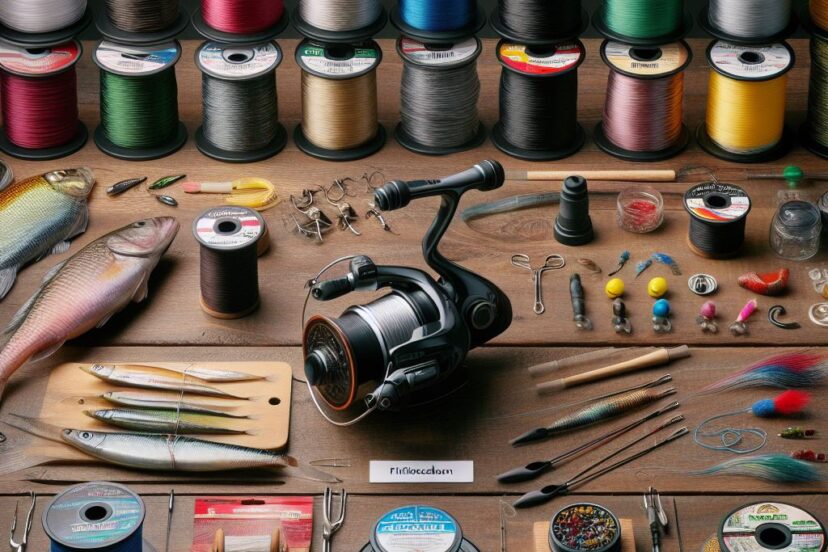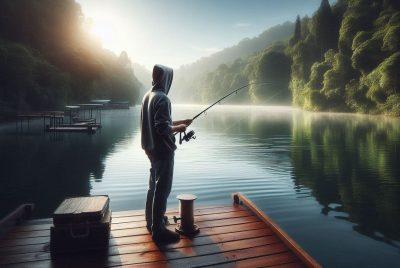Fishing Line Types: A Quick Guide
*We may earn a commission for purchases made using our links. Please see our disclosure to learn more.
Fishing Line Types: Your Comprehensive Guide
As a passionate fishing enthusiast, I understand the importance of selecting the right fishing line. Fishing line is the crucial link between you and the fish you aim to catch. The choice of fishing line can significantly impact your fishing experience and success. In this guide, I will provide you with insights into different fishing line types, their characteristics, advantages, and disadvantages. I’ll also offer recommendations based on fishing conditions and the species you target.
Understanding Fishing Line Materials
When it comes to fishing lines, there are three primary materials to choose from: monofilament, fluorocarbon, and braided lines. Let’s delve into each of these options.
Monofilament
Monofilament fishing lines are known for their versatility. They are made from a single strand of synthetic material and have been a popular choice among anglers for decades. Monofilament lines offer several advantages and a few drawbacks.
Advantages of Monofilament Fishing Line:
- Stretch: Monofilament lines have some stretch, which can be beneficial when fighting strong fish.
- Knot-Friendly: They are easy to tie knots with, making them suitable for beginners.
- Shock Absorption: They provide excellent shock absorption, reducing the chances of losing a fish during the fight.
Disadvantages of Monofilament Fishing Line:
- Visibility: Monofilament lines are more visible in the water, which can deter cautious fish.
- Knot Strength: Knots may weaken over time, so they require frequent retying.
Fluorocarbon
Fluorocarbon fishing lines have gained popularity due to their low visibility in the water and impressive sensitivity. They are made from a material that refracts light similarly to water, making them nearly invisible underwater.
Advantages of Fluorocarbon Fishing Line:
- Invisibility: Fish are less likely to detect fluorocarbon lines, increasing your chances of a successful catch.
- Abrasion Resistance: Fluorocarbon lines are highly resistant to abrasion, making them suitable for rugged conditions.
- Sensitivity: They provide excellent sensitivity, allowing you to feel even subtle bites.
Disadvantages of Fluorocarbon Fishing Line:
- Price: They tend to be more expensive than monofilament lines.
- Less Stretch: Fluorocarbon lines have less stretch, which may result in pulled hooks if not used with the right technique.
Braided
Braided fishing lines are made by weaving together multiple strands of synthetic material. They are known for their incredible strength and minimal stretch.
Advantages of Braided Fishing Line:
- Strength: Braided lines have a high strength-to-diameter ratio, allowing you to use thinner lines without sacrificing strength.
- Durability: They are resistant to abrasion and last longer than other types of lines.
- Minimal Stretch: Braided lines offer minimal stretch, providing excellent sensitivity.
Disadvantages of Braided Fishing Line:
- Visibility: They are highly visible underwater, which may deter fish in clear water.
- Knots: Braided lines can be challenging to tie knots with, and the knots may require extra care.
Choosing the Right Fishing Line for Your Needs

Selecting the right fishing line depends on various factors, including the fishing environment, weather conditions, and the species you intend to catch. Let’s explore these considerations.
Fishing Environment and Conditions
The environment you’ll be fishing in plays a significant role in your line choice. For instance:
- Saltwater Fishing: In saltwater, where fish are often larger and more aggressive, a strong and abrasion-resistant line like fluorocarbon or braided may be ideal.
- Freshwater Fishing: In freshwater, where visibility is essential, fluorocarbon may be the preferred choice.
- Ice Fishing: Ice fishing lines should have low visibility and good sensitivity, making fluorocarbon an excellent option.
Targeted Fish Species
Different fish species have varying behaviors and requirements. Understanding your target species is essential when selecting the right line.
- Bass Fishing: Bass are known for their strong fights. Braided lines offer excellent strength and sensitivity.
- Trout Fishing: Trout are usually found in clear, cold water. Fluorocarbon lines are less visible and more suited for this environment.
- Saltwater Fishing: Depending on the species, you may need a combination of lines to adapt to different fishing scenarios.
Specialty Fishing Line Types
Apart from the primary fishing lines, there are several specialty lines available for specific purposes. These include:
Copolymer Lines
Copolymer lines combine the benefits of monofilament and fluorocarbon lines, offering good strength, low visibility, and ease of knot tying.
Lead Core Lines
Lead core lines are weighted lines used for fishing at specific depths, such as deep trolling for lake trout.
Wire Lines
Wire lines are extremely strong and are used for deep-sea fishing to handle powerful fish.
Fly Fishing Lines
Fly fishing lines are specially designed for fly casting and come in various tapers and densities for specific fishing techniques.
Factors to Consider when Selecting a Fishing Line
When choosing a fishing line, consider the following factors:
Line Strength and Diameter
The line’s strength should match the fish you intend to catch, while the diameter affects casting distance and visibility.
Knot Strength
Choose a line that allows for strong and reliable knots.
Stretch and Sensitivity
Consider the level of stretch and sensitivity needed for the type of fishing you’ll be doing.
Abrasion Resistance
Factor in the potential for abrasion in the fishing environment, and choose a line that can withstand it.
Tips for Maintaining and Using Fishing Line Types
Proper maintenance and usage of fishing lines are essential for a successful fishing trip.
- Line Storage: Store your fishing lines away from direct sunlight and extreme temperatures to prevent degradation.
- Knot Tying: Learn and practice proper knot-tying techniques to ensure your knots remain strong.
- Line Replacement: Regularly inspect your lines for damage and replace them as needed to avoid disappointment on the water.
Conclusion
In the world of fishing, the choice of fishing line is not to be taken lightly. Understanding the characteristics and considerations for each type of line is crucial for your success as an angler. Whether you opt for monofilament, fluorocarbon, braided, or a specialty line, always match your choice to your fishing environment, conditions, and target species. A well-informed decision can make all the difference between a memorable catch and a lost opportunity.
FAQs About Fishing Line Types
- What is the best fishing line for beginners?
- Monofilament lines are often recommended for beginners due to their ease of use and knot-friendliness.
- Can I use the same fishing line for all types of fishing?
- It’s best to choose a line that suits the specific fishing conditions and target species to maximize your success.
- How often should I replace my fishing line?
- Regularly inspect your line for signs of wear and replace it when it shows visible damage or wear and tear.
- Why is visibility important in fishing line selection?
- In clear water, fish can be cautious, so using a less visible line like fluorocarbon can increase your chances of getting a bite.
- What is the purpose of lead core lines in fishing?
- Lead core lines are used to reach specific depths when trolling for fish, allowing anglers to target fish at various water levels.
Now that you have a comprehensive understanding of fishing line types, go out and make the most of your angling adventures with the right fishing line choice. Happy fishing!




